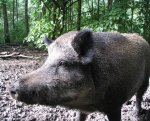 The Wild Boar (Sus scrofa) is the ancestor of the domestic pig. Its weight can reach up to 300 kilograms! Although 'boar' usually means male pig, the Wild boar is the name of the species. The males have both upper and lower tusks, while females have none. When in a group of pig, the pigs are called 'sounders'. Before the invention of synthetic fibers, toothbrushes were made from the hair on the back of a boar, although they contained lots of bacteria...
The Wild Boar (Sus scrofa) is the ancestor of the domestic pig. Its weight can reach up to 300 kilograms! Although 'boar' usually means male pig, the Wild boar is the name of the species. The males have both upper and lower tusks, while females have none. When in a group of pig, the pigs are called 'sounders'. Before the invention of synthetic fibers, toothbrushes were made from the hair on the back of a boar, although they contained lots of bacteria... Picture of the wild boar by GerardM, 2004
Which zoos have them?
Minnesota Zoo (United States)The Wild boar is listed as Least Concern (LR/lc), lowest risk. Does not qualify for a more at risk category. Widespread and abundant taxa are included in this category, on the IUCN Red List of Threatened Species
Countries
Afghanistan, Albania, Algeria, Andorra, Austria, Belarus, Belgium, Bosnia and Herzegovina, Bulgaria, Burma, Cambodia, Croatia, Czech Republic, Egypt, Estonia, Finland, France, Germany, Greece, Hungary, India, Indonesia, Iran, Ireland, Italy, Japan, Korea, North, Korea, South, Laos, Latvia, Libya, Liechtenstein, Lithuania, Luxembourg, Macedonia, Malaysia, Morocco, Nepal, Netherlands, Norway, Pakistan, Philippines, Poland, Romania, Russia, Serbia and Montenegro, Singapore, Slovakia, Slovenia, Spain, Sri Lanka, Switzerland, Taiwan, Thailand, Tunisia, Turkey, Turkmenistan, Ukraine, United Kingdom and VietnamSome facts about the
Wild boar
Adult weight : 180 kg (396 lbs)
Maximum longevity : 27 years
Female maturity :334 days
Male maturity : 768 days
Gestation : 115 days
Weaning : 56 days
Litter size : 7
Litters per year : 2
Interval between litters : 230 days
Weight at birth : 0.96 kg (2.112 lbs)
Weight at weaning : 5.7 kg (12.54 lbs)
Basal metabolic rate : 104 W
Body mass : 135 kg (297 lbs)

Custom Search